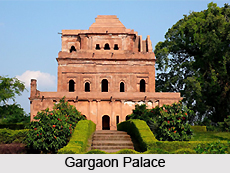 Sibsagar was known as the former capital of the Ahoms, who ruled Assam for more than 600 years till the advent of British. One of the oldest towns in Assam, Sibsagar - "The Ocean of Shiva"- lies 60-km east of Jorhat and 369-km from Guwahati and is an important centre for the tea and oil trades. It`s cluster of monuments from six centuries of Ahom rule are still of significance to modern Assamese culture.
Sibsagar was known as the former capital of the Ahoms, who ruled Assam for more than 600 years till the advent of British. One of the oldest towns in Assam, Sibsagar - "The Ocean of Shiva"- lies 60-km east of Jorhat and 369-km from Guwahati and is an important centre for the tea and oil trades. It`s cluster of monuments from six centuries of Ahom rule are still of significance to modern Assamese culture.
A huge artificial tank, constructed by Queen Madambika in 1734, lies at the heart of the complex. Rising from its southern shore, the massive plain 32-metre-high Shivadol is the tallest Shiva temple in India, flanked by smaller temples dedicated to Durga and Vishnu. Pilgrims come from all over the state visit this temple during the Shivaratri festival. On the western shore of the lake next to a park, the Tai Ahom Museum contains a few ill-labeled artefacts.
Modern Sibsagar is a fast developing town and is the headquarters of the district of the same of name. The Eastern Regional Headquarters of the Oil and natural Gas commission is located at Nazira only a few kilometres away from the town.
Rang Ghar
Nearly 4 km from Sibsagar west of the centre of the town is the Rang Ghar pavilion from which the royal family watched traditional games such as buffalo fighting.
Kareng Dhar & Talatal Ghar
A seven-storied palace having three storeys underground is known as Talatal Ghar and the upper storey is known as Kareng Ghar were built by King Rudra Singha (1696-1714) and are situated 6-km away from Sibsagar town. There were two underground tunnels from the Talatal Ghar connecting Dikhow River and Gargaon place, which were later blocked by the East India Company.
Rang Ghar
A two-storied oval shaped pavilion from which Ahom royalties watched elephant fight and other sporting events. It was built by King Parmatta Singha (1744-1751) and stands close to the Kareng Ghar.
 Gargaon Palace
Gargaon Palace
Gargaon, the principal town of Ahoms built by the XV King Suklenmung in 1540, lies 13-km east of Sibsagar. The old palace was destroyed and King Rajeswar Singha rebuilt the present seven-storied palace around 1762.
Jaysagar Tank and Temples
The tank was built by King Rudra Singha in memory of his mother, Joymoti, a patriotic martyr in 1697 at Rangpur (5-km). It covers an area of 318 acres and on its bank 3 temples were built in 1698 by the same monarch. These are the Joydol (Vishnu temple), the Shivadol and the Devidol, which are highly revered.
Gaurisagar Tank and Temples
The Gaurisagar tank was built by queen Phuleswari Devi (1722- 1791) and was dedicated to goddess Durga. It is covering an area of 150 acres and enclosing Shivadol and the Vishnudol temples. Gaurisagar is only 12-km from Sibsagar.
Rudrasagar Tank and Temple
King Lakshmi Singha built the tank in 1773 in memory of his father King Rudra Singha. On its banks stand a Shiva Temple and is situated 8-km away from the Sibsagar town.
Namdang Stone Bridge
The Bridge, cut out from a single solid rock over the Namdang River is situated 12-km away from Sibsagar. It was constructed by workmen brought from Bengal during the reign of King Rudra Singha in 1703.
 Charaideo
Charaideo
The original capital of the Ahom kings, built by Sukapha, the founder of the Ahom dynasty, in 1253 AD is 28-km east of Sibsagar town. It is famous for the numerous "Maidams" or burial vaults of king and other members of the royal families.
Ajan Pir Dargah Sharif
At Saraguri Chapori (22-km) stands Ajan Pir Dargah Sharif. Ajan Pir was the first Muslim saint to compose "Zikir" in Assamese language. On the day of the "Urs" thousand of devotees gather here to pay homage to the memories of this great Muslim reformer.
Charaiadeo
28 km away from has a number of burial vaults of kings and noblemen and has a striking resemblance to Egypt`s pyramids.
Other Places And Shrines Of Interest
There are a great number of Vaishvava Sattras, Muslim Dargahs, Buddhist and Sakta shrines situated in and around Sibsagar. There are more than 500 tanks, vaults, earthen forts and "Rajbaries" (Castles), belonging to the Ahom, Manipuri, Jaintia and Shan Princes and Kachari kings.
Getting There
By Rail
Simaluguri, the nearest railhead, 20-km east, is served by frequent buses from the junction 200m north, all passing through Gargaon.
By Road
From the ASTC bus stand, 300m east at the junction of Hospital road and AT road, one can find regular bus services to Jorhat, Kaziranga, Guwahati, Tezpur and Tinsukia. The private bus stand is situated across the road. Three daily buses serve Charaideo from the Saheli stand, by the same junction. For Gaurisagar, tempos can be picked up at the central market. Other local destinations are best reached by auto-rickshaw.

General Information
Location:
60-km East Of Jorhat, Assam
Famous As:
Centre For Tea & Oil Trades
Main Attractions:
Shivratri Festival & The Ahom Monuments
Historical Significance
Former Capital Of The Ahom Dynasty.



















